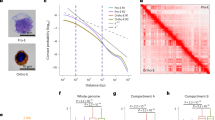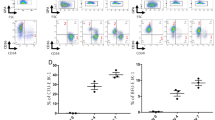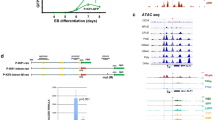Abstract
Ets-1 is a widely expressed transcription factor implicated in development, tumorigenesis and hematopoiesis. We analyzed Ets-1 gene expression during human erythroid and megakaryocytic (MK) differentiation in unilineage cultures of CD34+ progenitor cells. During erythroid maturation, Ets-1 is downmodulated and exported from the nucleus into the cytoplasm through an active mechanism mediated by a leucine-rich nuclear export signal. In contrast, during megakaryocytopoiesis Ets-1 increases and remains localized in the nucleus up to terminal maturation. Overexpression of Ets-1 in erythroid cells blocks maturation at the polychromatophilic stage, increases GATA-2 and decreases both GATA-1 and erythropoietin receptor expression. Conversely, Ets-1 overexpressing megakaryocytes are characterized by enhanced differentiation and maturation, coupled with upmodulation of GATA-2 and megakaryocyte-specific genes. We show that Ets-1 binds to and activates the GATA-2 promoter, in vitro and in vivo, indicating that one of the pathways through which Ets-1 blocks erythroid and promotes MK differentiation is via upmodulation of GATA-2 expression.
Similar content being viewed by others
Log in or create a free account to read this content
Gain free access to this article, as well as selected content from this journal and more on nature.com
or
Abbreviations
- HPCs:
-
hematopoietic progenitor cells
- NES:
-
nuclear export signal
- NLS:
-
nuclear localization signal
- CRM1/exportin1:
-
chromosome region maintenance1/exportin1
- FLC:
-
Friend erythroleukemia cells
- GFP:
-
green fluorescent protein
- RT-PCR:
-
reverse transcriptase polymerase chain reaction
- E:
-
erythroid
- MK:
-
megakaryocytic
- EBS:
-
ets binding site
- LMB:
-
leptomycin B
- IRES:
-
internal ribosome entry site
References
Oikawa T and Yamada T (2003) Molecular biology of the Ets family of transcription factors. Gene 303: 11–34
Papas TS, Bhat NK, Spyropoulos DD, Mjaatvedt AE, Vournakis J, Seth A and Watson DK (1997) Functional relationships among ETS gene family members. Leukemia 11: 557–566
Watson DK and Seth A (2000) Ets Gene Family. Oncogene Rev. 19 (55) review issue 5, Macmillan Publishers Ltd
Hahn SL and Wasylyk B (1994) The oncoprotein v-ETS is less selective in DNA binding than c-ETS-1 due to the C-terminal sequence change. Oncogene 9: 2499–2512
Cowley DO and Graves BJ (2000) Phosphorylation represses Ets-1 DNA binding by reinforcing autoinhibition. Genes Dev. 14: 366–376
Seidel JJ and Graves BJ (2002) An ERK2 docking site in the Pointed domain distinguishes a subset of ETS transcription factors. Genes Dev. 16: 127–137
Lelievre E, Lionneton F, Soncin F and Vandenbunder B (2001) The Ets family contains transcriptional activators and repressors involved in angiogenesis. Int. J. Biochem. Cell Biol. 4: 391–407
Bories JC, Willerford DM, Grevin D, Davidson L, Camus A, Martin P, Stehelin D and Alt FW (1995) Increased T-cell apoptosis and terminal B-cell differentiation induced by inactivation of the Ets-1 proto-oncogene. Nature 377: 635–638
Barton K, Muthusamy N, Fischer C, Ting CN, Walunas TL, Lanier LL and Leiden JM (1998) The Ets-1 transcription factor is required for the development of natural killer cells in mice. Immunity 9: 555–563
Sieweke MH, Tekotte H, Frampton J and Graf T (1996) MafB is an interaction partner and repressor of Ets-1 that inhibits erythroid differentiation. Cell 85: 49–60
Clausen PA, Athanasiou M, Chen Z, Dunn KJ, Zhang Q, Lautenberger JA, Mavrothalassitis G and Blair DG (1997) Ets-1 induces increased expression of erythroid markers in the pluripotent erythroleukemic cell lines K562 and HEL. Leukemia 11: 1224–1233
Kraut N, Frampton J, McNagny KM and Graf T (1994) A functional ETS DNA-binding domain is required to maintain multipotency of hematopoietic progenitors transformed by Myb-Ets. Genes Dev. 8: 33–44
Rossi F, McNagny KM, Logie C, Stewart AF and Graf T (1996) Excision of Ets by an inducible site-specific recombinase causes differentiation of Myb-Ets-transformed hematopoietic progenitors. Curr. Biol. 6: 866–872
Teuri K, Takashi Y, Kitazawa J, Toki T, Yokoyama M and Ito E (2000) Expression of transcription factors during megakaryocytic differentiation of CD34+ cells from human cord blood induced by thrombopoietin. Tohoku. J. Exp. Med. 192: 259–273
Shivdasani RA (2001) Molecular and transcriptional regulation of megakaryocyte differentiation. Stem Cell 19: 397–407
Tsai FY, Keller G, Kuo FC, Weiss M, Chen J, Rosenblatt M, Alt FW and Orkin SH (1994) An early hematopoietic defect in mice lacking the transcription factor GATA-2. Nature 371: 221–226
Tsai FY and Orkin SH (1997) Transcription factor GATA-2 is required for proliferation/survival of early hematopoietic cells and mast cell formation, but not for erythroid and myeloid terminal differentiation. Blood 89: 3636–3643
Shivdasani RA and Orkin SH (1996) The transcriptional control of hematopoiesis. Blood 87: 4025–4039
Ikonomi P, Rivera CE, Riordan M, Washington G, Schechter AN and Noguchi CT (2000) Overexpression of GATA-2 inhibits erythroid and promotes megakaryocyte differentiation. Exp. Hematology 28: 1423–1431
Kamesaki H, Michaud GY, Irving SG, Suwabe N, Kamesaki S, Okuma M and Cossman J (1996) TPA-induced arrest of erythroid differentiation is coupled with downregulation of GATA-1 and upregulation of GATA-2 in an erythroid cell line SAM-1. Blood 87: 999–1005
Ohneda K and Yamamoto M (2002) Roles of hematopoietic transcription factors GATA-1 and GATA-2 in the development of red blood cell lineage. Acta Haematol. 108: 237–245
Visvader JE, Crossley M, Hill J, Orkin SH and Adams JM (1995) The C-terminal zinc finger of GATA-1 or GATA-2 is sufficient to induce megakaryocytic differentiation of an early myeloid cell line. Mol. Cell. Biol. 15: 634–641
Marziali G, Perrotti E, Ilari R, Lulli V, Coccia EM, Moret R, Kuhn LC, Testa U and Battistini A (2002) Role of Ets-1 in transcriptional regulation of transferrin receptor and erythroid differentiation. Oncogene 21: 7933–7944
Mattaj IW and Englmeier L (1998) Nucleocytoplasmic transport: the soluble phase. Annu. Rev. Biochem. 67: 265–306
Ducret C, Maira SM, Dierich A and Wasylyk B (1999) The Net repressor is regulated by nuclear export in response to anisomycin, UV, and heat shock. Mol. Cell. Biol. 19: 7076–7087
Wood LD, Irvin BJ, Nucifora G, Luce KS and Hiebert SW (2003) Small ubiquitin-like modifier conjugation regulates nuclear export of TEL, a putative tumor suppressor. Proc. Natl. Acad. Sci. 100: 3257–3262
Fleenor DE, Langdon SC, deCastro CM and Kaufman RE (1996) Comparison of human and Xenopus GATA-2 promoters. Gene 179: 219–223
Kola I, Brookes S, Green AR, Garber R, Tymms M, Papas TS and Seth A (1993) The ETS-1 transcription factor is widely expressed during murine embryo development and is associated with mesodermal cells involved in morphogenetic processes such as organ formation. Proc. Natl. Acad. Sci. 90: 7588–7592
Koury MJ, Sawyer ST and Brandt SJ (2002) New insights into erythropoiesis. Curr. Opin. Hematol. 9: 93–100
Imagawa S, Yamamoto M and Miura Y (1997) Negative regulation of the erythropoietin gene expression by the GATA transcription factors. Blood 4: 1430–1439
Deveaux S, Filipe A, Lemarchandel V, Ghysdael J, Romeo PH and Mignotte V (1996) Analysis of the thrombopoietin receptor (MPL) promoter implicates GATA and Ets proteins in the coregulation of megakaryocyte-specific genes. Blood 87: 4678–4685
Minami T, Tachibana K, Imanishi T and Doi T (1998) Both Ets-1 and GATA-1 are essential for positive regulation of platelet factor 4 gene expression. Eur. J. Biochem. 258: 879–889
Lemarchandel V, Ghysdael J, Mignotte V, Rahuel C and Romeo PH (1993) GATA and Ets cis-acting sequences mediate megakaryocyte-specific expression. Mol. Cell. Biol. 13: 668–676
Eisbacher M, Holmes ML, Newton A, Hogg PJ, Khachigian LM, Crossley M and Chong BH (2003) Protein-protein interaction between Fli-1 and GATA-1 mediates synergistic expression of megakaryocyte-specific genes through cooperative DNA binding. Mol. Cell. Biol. 23: 3427–3441
Pereira R, Quang CT, Lesault I, Dolznig H, Beug H and Ghysdael J (1999) FLI-1 inhibits differentiation and induces proliferation of primary erythroblasts. Oncogene 18: 1597–1608
Starck J, Doubeikovski A, Sarrazin S, Gonnet C, Rao G, Skoultchi A, Godet J, Dusanter-Fourt I and Morle F (1999) Spi-1/PU.1 is a positive regulator of the Fli-1 gene involved in inhibition of erythroid differentiation in Friend Erythroleukemic cell lines. Mol Cell Biol. 19: 121–135
Bhat NK, Fisher RJ, Fujiwara S, Ascione R and Papas TS (1987) Temporal and tissue-specific expression of mouse ets genes. Proc. Natl. Acad. Sci. 84: 3161–3165
Breton-Gorius, J, Favier R, Guichard J, Cherif D, Berger R, Debili N, Vainchenker W and Douay L (1995) A new congenital dysmegakaryopoietic thrombocytopenia (Paris-Trousseau) associated with giant platelet alpha-granules and chromosome 11 deletion at 11q23. Blood 85: 1805–1814
Coppola S, Narciso L, Feccia T, Bonci D, Calabrò L, Morsilli O, Gabbianelli M, De Maria R, Testa U and Peschle C (2005) Enforced expression of KDR receptor promotes proliferation, survival and megakaryocytic differentiation of TF1 progenitor cell line. Cell Death Differentiation X: 1–14
Kilstrup-Nielsen C, Alessio M and Zappavigna V (2003) PBX1 nuclear export is regulated independently of PBX-MEINOX interaction by PKA phosphorylation of the PBC-B domain. EMBO J. 22: 89–99
Acknowledgements
This work was supported by institute fund from the Istituto Superiore di Sanità and Grant from the Italy-USA program on ‘Therapy of Tumors’. The authors gratefully acknowledge Stuart Orkin (Children’ Hospital, Boston, MA) and Vincenzo Zappavigna (University of Modena and Reggio Emilia, Modena, Italy) for providing reagents, Ruggero De Maria for critically reading the manuscript, Mariangela Fontana and Monica Blasi for editorial assistance and Alfonso Zito and Giuseppe Loreto for graphics.
Author information
Authors and Affiliations
Corresponding author
Additional information
Edited by G Ciliberto
Rights and permissions
About this article
Cite this article
Lulli, V., Romania, P., Morsilli, O. et al. Overexpression of Ets-1 in human hematopoietic progenitor cells blocks erythroid and promotes megakaryocytic differentiation. Cell Death Differ 13, 1064–1074 (2006). https://doi.org/10.1038/sj.cdd.4401811
Received:
Revised:
Accepted:
Published:
Issue date:
DOI: https://doi.org/10.1038/sj.cdd.4401811
Keywords
This article is cited by
-
Insight into microRNAs’ involvement in hematopoiesis: current standing point of findings
Stem Cell Research & Therapy (2023)
-
Role of the pioneer transcription factor GATA2 in health and disease
Journal of Molecular Medicine (2023)
-
Gata2-L359V impairs primitive and definitive hematopoiesis and blocks cell differentiation in murine chronic myelogenous leukemia model
Cell Death & Disease (2021)
-
The role of GATA2 in lethal prostate cancer aggressiveness
Nature Reviews Urology (2017)
-
Notch1-promoted TRPA1 expression in erythroleukemic cells suppresses erythroid but enhances megakaryocyte differentiation
Scientific Reports (2017)



